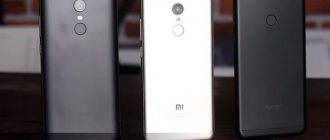Xiaomi
The Xiaomi brand does not produce its own processors; the company purchases hardware from Qualcomm or Mediatek, which are leaders in the development of processors for mobile phones.
The operation of a Qualcomm-based smartphone is a huge advantage, because the chip and electronic boards require relatively little power consumption, but at the same time provide high performance. First of all, this concerns the flagships - Snapdragon 821, 835, 845. Due to this, Xiaomi smartphones are ahead of their competitors.
Every Xiaomi phone runs on Android. However, the work is not limited to this; they additionally install their own development on a clean operating system - the MIUI shell. This decision is controversial, since many users find it inconvenient to use the interface due to the specific arrangement of screen elements. They also highlight the problem of Russification - some models simply don’t have it, which forces users to download third-party programs to flash the phone’s firmware. In this case, the device may automatically lock.
In addition, the MIUI shell is poorly optimized, which is why with a battery charge of 3000 mA/h the phone will have to be charged every day. There are complaints from users - some firmware has automatically built-in advertising integration, which appears on the screen with enviable frequency.
Performance
Xiaomi equips its smartphones with chipsets from the American company Qualcomm. It is a rare case when Chinese MidiaTek are installed. The 2021 flagship Mi 9 (35 thousand rubles) received an eighth-generation Snapdragon 855+ processor, accelerating to 2.96 GHz. Simpler models have versions 625, 730, etc.
Huawei traditionally works with native chipsets from its subsidiary HiSilicon. The 2021 Kirin 980, built using a 7nm process technology, turned out to be so powerful that it is still rated very highly. For example, it was installed in the premium P30 Pro, which at the time of its release in 2021 cost about 50 thousand rubles.
The Antutu rating leaves no doubt that the Snapdragon 855 Plus is the best in its segment.
In Antutu tests for January 2021, the Snapdragon 855 Plus scored 488616 points, and the Kirin 980 scored 406314. The example processors are not new; the Snapdragon 865 and Kirin 990 have already been released. But smartphones for ordinary mortals will continue to have previous versions installed for several years. which is common practice. As for the absolute champion in performance, it was the Apple A13 Bionic, which received 479,034 points.
Huawei
Huawei is rightfully considered a giant in the production of mobile gadgets. The company doesn't just assemble phones from purchased parts, it creates its own.
HiSilicon mobile chips are head and shoulders above Xiaomi or Samsung processors. The tenth generation Kirin 970 electronic board is equipped with a Mali-G72 12-core GPU.
Comparison of rulers
To determine which company ranks first, you need to consider the main indicators and compare Xiaomi and Miezu and Huawei smartphones.
Display
The developers try to make the screen of each model in Full HD format with a resolution of 1920x1080, with a density of 400 - 430 pixels per inch. This amount allows you to comfortably use the phone without any problems.
Meizu and Huawei smartphones are equipped with a screen with an AMOLED matrix, which has its drawbacks. The contrast of the image fades into the background, since when lit in sunny weather, problems arise with visibility on the screen. In addition, if you rotate the phone at different angles, a greenish tint appears at the edges of the display.
Xiaomi phones are equipped with an IPS panel that improves image quality and resistance to glare and sunlight. Its brightness reserve is higher.
Camera
The Huawei line is doing better with the camera. Each model has a dual camera, the company's own development. Most users believe that this function is necessary to create the effect of a panoramic space or to expand the camera's viewing angle. This is not true; with this technology, developers are trying to maximize the number of light particles in the camera. Both cameras are 12 MP, however, one takes photographs in color, the second takes only black and white photos.
The 3 main advantages of the camera are laser, image depth and contrast. They are Huawei's signature design and help you create high-quality images using autofocus.
Smartphones from Xiaomi and Meizu lag behind in this indicator. Insufficient light transmission and poor focus development create pictures of worse quality than Huawei. Images appear darker than the original.
Appearance
For several years now, Meizu smartphones have been almost impossible to distinguish externally from iPhones. Xiaomi and Meizu phones look strict, the metal body with side roundings creates the effect of style and high cost, but as soon as you take the smartphone in your hand, this feeling disappears. Upon closer inspection, one detail catches the eye - to give the appearance of metal, the aluminum was simply painted in a color with shades of metal. However, this procedure makes it harder to drop the phone from your hands.
A distinctive feature of Meizu is its thickness, which is why you don’t need to squeeze the phone anymore to prevent it from falling out. The manufacturer has made every effort to ensure that the models have a sophisticated appearance.
Edges that reflect light when it hits the screen and strong pollination make Xiaomi look rougher in appearance. The back is tapered, which is not the case with Meizu.
Huawei, in appearance, resembles an equilateral rectangle. No curves, the back is made of metal or glass. Side edges made of aluminum alloy. In terms of its dimensions, Huawei is longer.
Comfortable to hold in hand
In this indicator of the battle Xiaomi vs Huawe vs Meizu it is difficult to identify the winner. Each manufacturer tries to create its own unique style, but it is not a fact that it will suit every client.
Huawei, due to its metal body, is easier to drop when holding it, but at the same time, the evenness of the edges neutralizes this indicator. Holding a smartphone is not only convenient, but also pleasant.
With the Xiaomi and Meizu models, things are simpler; the case's dusting and rounded edges allow the owner to minimize the risk of falling. The phone fits well in the hand.
Advantages and disadvantages
The detailed description in the table below will help answer the question: Meizu, Xiaomi or Huawei, which is better to choose?
| Firm | Advantage | Flaws |
| Xiaomi | 1. Cost. The clear leader in the budget segment. The company produces flagships at affordable prices and it is unlikely that any of its competitors will be able to come close to this indicator. | 1. Firmware. The main disadvantage. The lack of Russification and dancing with a tambourine scare off many potential clients. The main emphasis is on the European market. You can also add problems with the bootloader, which can block the phone if it suspects an attempt to flash the firmware on its own. |
| 2. Autonomy. Despite the low cost, every Xiaomi phone has a powerful battery. In some, the battery capacity is more than 4000 mA/h. This does not prevent the smartphone from remaining thin and elegant. | 2.Camera. If the hardware does not suffer due to the low cost, then the camera leaves much to be desired. Add to this the lack of autofocus, which requires photographing the subject several times to fully capture it. | |
| 3. Productivity. It loses to Huawei phones in this indicator, but the hardware is still of high quality. When buying even a cheap phone, you can always count on good components. | ||
| Huawei | 1. Large selection. While competitors make the case from plastic or aluminum, Huawei pampers its customers with glass or plastic options. | 2. Confusion. Despite the large assortment, the different models are simply not structured. It is also confusing that the internal equipment of the same model is different for different regions. |
| 2. Iron. When purchasing a Huawei smartphone, there is always a guarantee of quality, because the hardware is from one manufacturer. Chips that are inferior in quality and performance to such flagships as the iPhone or Samsung definitely deserve attention | 2. Buttons on the screen. Irrational use of the phone's dimensions has led to the fact that the buttons are placed directly on the screen. All developers are trying to get rid of this element of the past, while Huawei continues to do the same thing. | |
| 3. Official distribution. The company has its own stores in all countries of the world. There is no need to turn to resellers for fear of being scammed, because you can simply buy directly from the manufacturer. | 4. No oleophobic coating. Even the budget Xiaomi model has this coating, but Huawei stubbornly continues to ignore the positive functions of this coating. | |
| 4.Camera. Dual camera, 12 megapixels, detailed autofocus. Such credentials make Huawei the leader in the budget segment in this indicator. | 4. Cost. Significantly more expensive than its competitors, but there is something to overpay for. | |
| Meizu | 1. FlymeOS shell. When actively using the phone, it is difficult to encounter the problem of freezing. | 1. Warranty. The warranty is official, but only for half a year. |
| 2. Battery capacity. The average battery life is 5 hours. | 2. Using Mediatek chips. The transition of smartphones to the Snapdragon electronic board will help cope with this problem. At the moment, Meizu quickly heats up and begins to freeze with active use. | |
| 3. Touch navigation function. You can navigate using the Home button. | ||
| 4. Camera. It’s not the same as Huawei’s, but it still pleases with its high-quality pictures. |
Cameras
Operating system for Xiaomi smartphones
When creating smartphones, Xiaomi developers are forced to make compromises. It is impossible to create cheap devices with high-quality cameras, because good optics are expensive. It is difficult to compete with Huawei, since the company has a long and strong cooperation with the German brand Leica, which has been specializing in the production of cameras since 1925. Even budget models are equipped with good sensors and multi-layer lenses, which allows you to create excellent pictures. The emergence of AI technologies has somewhat smoothed the situation, but Huawei still remains a manufacturer of real camera phones.
On the question of the number of cameras. The main module is usually equipped with 2-3-4 lenses, which significantly improves the quality of shots. As for the front block, in advanced models it is now hidden in the body, popping out when taking photographs. Time will tell how successful this decision will be.
Reviews
Huawei
Anton: “I love taking photographs, it’s my weakness! Because of this, I chose Huawei. The dual camera with excellent autofocus made me lean towards choosing this company.”
Denis: “When I came to the salon, I saw only a few Meizu models, and a huge Huawei department. There was plenty to choose from, I’m very happy with the purchase!”
Anastasia: “I really liked the glass case. Stylish and elegant. Yes, the cost is higher than competitors, but this purchase is worth it.”
Meizu
Dmitry: “Since Meizu entered the Russian market, I remain his devoted fan. I have already changed 3 phones, bought them as a gift for my wife. The price-quality ratio is excellent!”
Alice: “I was captivated by the appearance and compactness. Over several years of use, I have not encountered any problems in use, which is rare for budget phones.”
Igor: “The New Year’s gift for my son was received with a bang.” There is no limit to happiness. The design is simple, but pleasing. And you can play games.”
Xiaomi
Andrey: “For me, Xiaomi is always number one. The autonomy of the operation was amazing, the smoothness when changing the picture and the excellent fingerprint button. I liked it.”
Julia: “I liked the gold body of the phone. I’ve been using it for 2 years now, no problems.”
Boris: “Very pleased with the purchase. At this price, getting these features is incredible. I hope that in a couple of years it will also work.”
Appearance
A comparative analysis of the design of Xiaomi and Huawei phones is useless. Both companies carefully follow the trends set by premium devices from Apple and Samsung. Over the previous year, Xiaomi released several lines with various modifications - Mi 9, Mi A3, Redmi 7/K20/8. The number of Huawei lags somewhat behind - P Smart, P30, Y6/7 plus the model range of the subsidiary sub-brand Honor - View 20, 10i, 8A, 9X. The problem is that it is sometimes impossible to distinguish phones at first glance.
Redmi Note 7 and Huawei P Smart: two from the casket are identical in appearance.
Using the example of the new Redmi Note 7 and Huawei P Smart, you can see the similarity in appearance. Both models have a very vertically elongated body, rounded corners and edges. The front camera lens is enclosed in a semicircular droplet. And only at a second glance it becomes noticeable that Redmi has larger frames, and the phone itself looks more brutal in contrast to its elegant, streamlined rival. It’s difficult to say which phone is better, it’s a matter of taste, and as you know, there’s no arguing about it.










